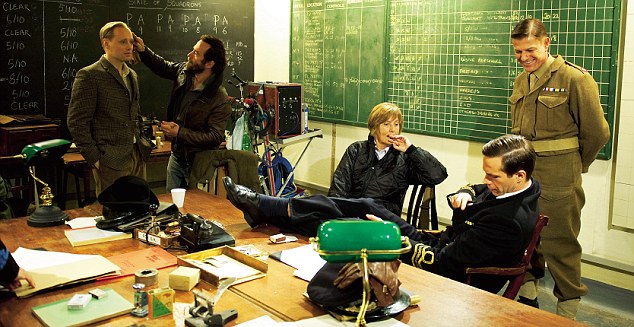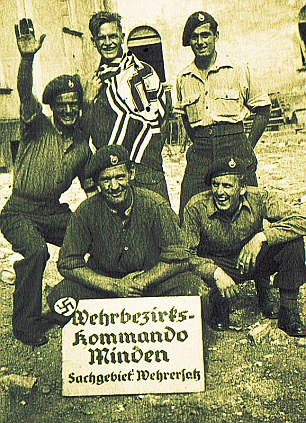http://www.dailymail.co.uk/home/moslive/article-1388792/James-Bonds-inspiration-brought-life-evocative-new-movie-Age-Of-Heroes.html

On the set of Ages Of Heroes, the new film starring Sean Bean (standing on right) about Ian Fleming's 30AU unit. James D'Arcy (seated) plays the James Bond author
In 1942, a Whitehall official visited the notorious safebreaker and cat burglar John Ramsey in Peterhead prison.
The civil servant had an intriguing offer from a naval intelligence officer called Ian Fleming. If Ramsey was prepared to put his criminal expertise to use in the war effort, he could expect a pardon. Ramsey, who had learnt to use explosives in the mining industry, readily agreed.
He was soon training with 30 Assault Unit (30AU), a new covert force formed by Fleming to seize Nazi military technology and scientists.
Safe-breaking skills were essential to Fleming’s plans. The Germans kept blueprints for missiles and radar equipment in bank vaults. An expert was needed to blow the safes. Ramsey is said to have cracked 14 in one day while in action in Italy.
The blurring of crime and war may have gone further. Some 30AU members suggest that looted gold and diamonds found in the vaults they raided were seen as a perk of the job. After the unit was disbanded, several men, looking for work, may have utilised their skill set on the other side of the law. Ramsey himself reverted to his old trade and was soon back in jail.

30AU commandos in Germany, 1945. They were a covert force formed by Ian Fleming to seize Nazi military technology and scientists
Unsurprisingly, 30AU’s secrecy and unusual recruitment methods were met with suspicion. George Patton, the US general, dismissed them as ‘a bunch of Limey pirates’.
Even a member of 30AU described their exploits as ‘running around Europe doing what we want’. They were, he said, ‘ghosts on the battlefield’.
Fleming went on to use several colourful personalities from the unit as templates for the character of James Bond, but the existence of 30AU itself was kept secret even after the war, robbing it of a place in history.
Now, for the first time, a British thriller, Age Of Heroes, puts on record the unit’s achievements. Starring Sean Bean and Danny Dyer, the film depicts a daring raid on a Nazi radar installation in Norway. Fleming’s covert force was the only intelligence-gathering unit trained and armed well enough to fight its way to targets.
Chillingly, he signed an order saying: ‘The necessity for avoiding or eliminating witnesses to successful action… is emphasised’. The message was unambiguous: they had a licence to kill.
The unit’s motto was ‘attain by surprise’. Most operations were behind enemy lines, with groups dropped by parachute, landing from sea, or infiltrating on land ahead of Allied forces. Fleming, who was initially in charge of planning missions with Lt Cdr Jim Glanville, called the unit his ‘Red Indians’.
Suspicion of 30AU was compounded by its apparent independence from frontline command. Groups usually consisted of two jeeps, a naval officer, between five and eight Marines, and often a scientist to identify equipment and papers. The officer carried a ‘black list’ of targets. Orders allocating men to a specific target were only issued at the last minute.
One operation in Brittany ended in disaster. A 30AU truck carrying two captured German torpedoes exploded when bumping over a booby-trapped level crossing during a hasty exit. Two men on board were flung on to a minefield. A second truck and accompanying jeeps could not stop to recover the bodies from such a dangerous position.
In its first incarnation, 30AU saw action in North Africa, Italy, the Greek Islands, Corsica and Norway. An enlarged 30AU took part in the D-Day landings. Among their targets were V1 flying bomb launch facilities in France and the Netherlands, which they photographed and documented, before calling in Spitfires to obliterate the sites.
By the time of the Allied invasion of Germany, 30AU had 400 men. The biggest prize was in sight: the Nazis’ futuristic military technology, including long-range versions of the V2 missile, aimed at hitting New York. It wasn’t just the Allies who wanted the expertise of Nazi scientists; the advancing Soviet army was racing to secure it, too.
The unit captured a previously unknown facility north of Cologne, which was working on rockets, guided missiles, along with jet and rocket-propelled aircraft. The men of 30AU also captured top scientists, including Hellmuth Walter, designer of the Messerschmitt rocket plane prototype, and Herbert Wagner, who created the Henschel Hs293 guided glide bomb.
The final tally included 25 U-boats and two destroyers, captured at Bremen dockyards, and jet rockets and planes, torpedoes and mines. In May 1945, Fleming’s Red Indians took their biggest scalp: Admiral Karl Dönitz, who succeeded as Führer after Hitler killed himself. Contemporary accounts dispute 30AU’s part in his capture, but the unit’s history confirms it.
James Bond is reckoned to be a composite of half a dozen 30AU officers, including Lt Cdr Patrick Dalzel-Job, Lt Jim Besant and Lt Cdr Ralph Izzard, known as something of a ladies’ man. They certainly considered themselves to be above the constraints imposed on the average serviceman. Records say 30AU were given to ‘mischief’ and exhibited too much of a ‘party spirit’ when arriving in French towns at night.
Threatened with jail and possibly execution, 30AU’s men stayed silent about the unit’s exploits. The Navy posted spies around the quiet Sussex seaside town of Littlehampton, where 30AU were billeted during the war, to see no one talked. One member, overheard discussing an operation in a pub one night, had disappeared by the next day.
Some 30AU veterans were bitter about the way they were treated after the unit was disbanded in 1946. Ron Guy, a 30AU sniper, only talked about his adventures shortly before his death aged 80 in 2006. His grandson, Guy Allan Farrin, then researched the unit, creating a website, which was used as reference on Age Of Heroes.
Farrin remembers his grandad as ‘a bit of a scallywag’ with a short fuse.
‘I remember him showing me how to zero in my air rifle sights when I was a boy,’ says Farrin.
‘I thought he seemed very knowledgeable about it. Even then I knew there must be more to his war career than he was letting on.’
After his grandfather’s death, Farrin found notes written by him describing his time in 30AU.
In one, he wrote: ‘We felt invincible at times. We were trained by experts from all over the globe to become ghosts on the battlefield, behind enemy lines. Some thought we were just a bunch of murdering cutthroats but that was never the case.’ He said he was thankful he’d never had to use his doubled-edged Fairbairn-Sykes knife to kill anyone.
‘I saw my grandfather in a different light after I found all this out,’ says Farrin.
‘He was a difficult man, but now I understood why. What he did was beyond my comprehension. These men lived with what they went through completely internally, never having any outlet to express their turmoil. Secrecy had been drilled into them so thoroughly many took it all to the grave.’
Sean Bean agrees that the tale of 30AU needs to be told.
‘This is a little bit special because it affected so many millions of people all over the world. For some reason we seem to be a little bit ashamed of bringing these things up today. But it’s time people heard this story.’
